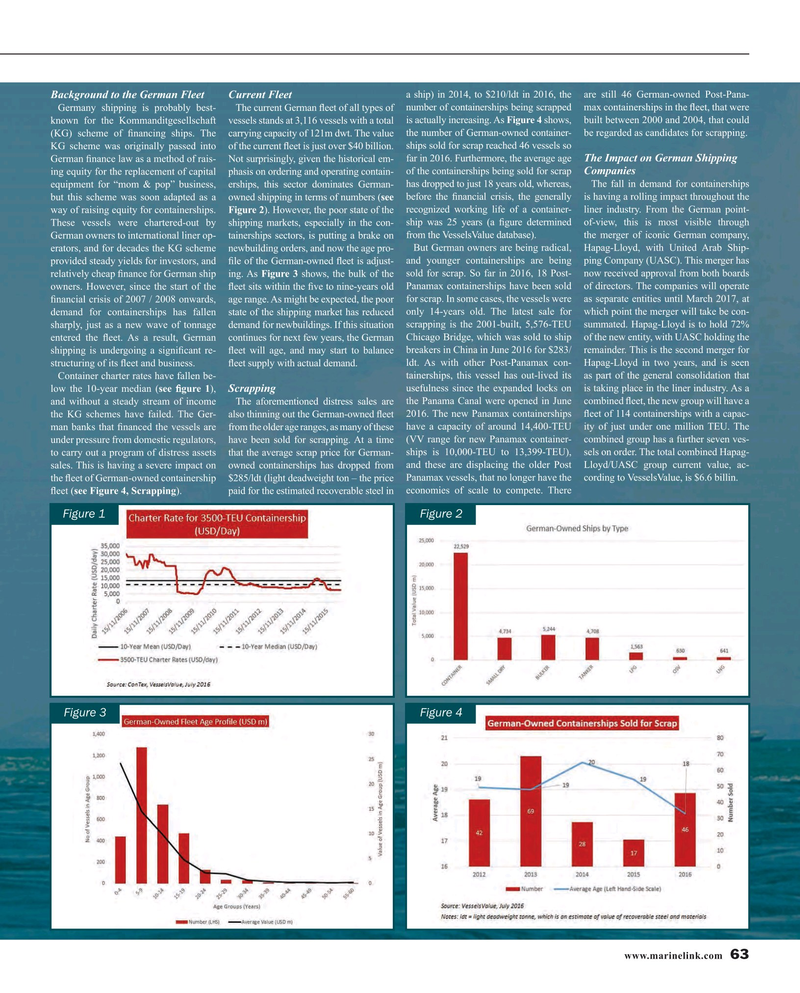
Page 63: of Maritime Reporter Magazine (August 2016)
The Shipyard Edition
Read this page in Pdf, Flash or Html5 edition of August 2016 Maritime Reporter Magazine
a ship) in 2014, to $210/ldt in 2016, the are still 46 German-owned Post-Pana-
Background to the German Fleet Current Fleet
Germany shipping is probably best- The current German ? eet of all types of number of containerships being scrapped max containerships in the ? eet, that were known for the Kommanditgesellschaft vessels stands at 3,116 vessels with a total is actually increasing. As Figure 4 shows, built between 2000 and 2004, that could (KG) scheme of ? nancing ships. The carrying capacity of 121m dwt. The value the number of German-owned container- be regarded as candidates for scrapping.
KG scheme was originally passed into of the current ? eet is just over $40 billion. ships sold for scrap reached 46 vessels so
The Impact on German Shipping
German ? nance law as a method of rais- Not surprisingly, given the historical em- far in 2016. Furthermore, the average age
Companies ing equity for the replacement of capital phasis on ordering and operating contain- of the containerships being sold for scrap equipment for “mom & pop” business, erships, this sector dominates German- has dropped to just 18 years old, whereas, The fall in demand for containerships but this scheme was soon adapted as a owned shipping in terms of numbers (see before the ? nancial crisis, the generally is having a rolling impact throughout the way of raising equity for containerships. Figure 2). However, the poor state of the recognized working life of a container- liner industry. From the German point-
These vessels were chartered-out by shipping markets, especially in the con- ship was 25 years (a ? gure determined of-view, this is most visible through
German owners to international liner op- tainerships sectors, is putting a brake on from the VesselsValue database). the merger of iconic German company, erators, and for decades the KG scheme newbuilding orders, and now the age pro- But German owners are being radical, Hapag-Lloyd, with United Arab Ship- provided steady yields for investors, and ? le of the German-owned ? eet is adjust- and younger containerships are being ping Company (UASC). This merger has relatively cheap ? nance for German ship ing. As Figure 3 shows, the bulk of the sold for scrap. So far in 2016, 18 Post- now received approval from both boards owners. However, since the start of the ? eet sits within the ? ve to nine-years old Panamax containerships have been sold of directors. The companies will operate ? nancial crisis of 2007 / 2008 onwards, age range. As might be expected, the poor for scrap. In some cases, the vessels were as separate entities until March 2017, at demand for containerships has fallen state of the shipping market has reduced only 14-years old. The latest sale for which point the merger will take be con- sharply, just as a new wave of tonnage demand for newbuildings. If this situation scrapping is the 2001-built, 5,576-TEU summated. Hapag-Lloyd is to hold 72% entered the ? eet. As a result, German continues for next few years, the German Chicago Bridge, which was sold to ship of the new entity, with UASC holding the shipping is undergoing a signi? cant re- ? eet will age, and may start to balance breakers in China in June 2016 for $283/ remainder. This is the second merger for structuring of its ? eet and business. ? eet supply with actual demand. ldt. As with other Post-Panamax con- Hapag-Lloyd in two years, and is seen
Container charter rates have fallen be- tainerships, this vessel has out-lived its as part of the general consolidation that low the 10-year median (see ? gure 1), usefulness since the expanded locks on is taking place in the liner industry. As a
Scrapping and without a steady stream of income The aforementioned distress sales are the Panama Canal were opened in June combined ? eet, the new group will have a the KG schemes have failed. The Ger- also thinning out the German-owned ? eet 2016. The new Panamax containerships ? eet of 114 containerships with a capac- man banks that ? nanced the vessels are from the older age ranges, as many of these have a capacity of around 14,400-TEU ity of just under one million TEU. The under pressure from domestic regulators, have been sold for scrapping. At a time (VV range for new Panamax container- combined group has a further seven ves- to carry out a program of distress assets that the average scrap price for German- ships is 10,000-TEU to 13,399-TEU), sels on order. The total combined Hapag- sales. This is having a severe impact on owned containerships has dropped from and these are displacing the older Post Lloyd/UASC group current value, ac- the ? eet of German-owned containership $285/ldt (light deadweight ton – the price Panamax vessels, that no longer have the cording to VesselsValue, is $6.6 billin.
? eet (see Figure 4, Scrapping). paid for the estimated recoverable steel in economies of scale to compete. There
Figure 1 Figure 2
Figure 3 Figure 4 www.marinelink.com 63
MR #8 (58-65).indd 63 8/1/2016 3:16:00 PM

 62
62

 64
64
